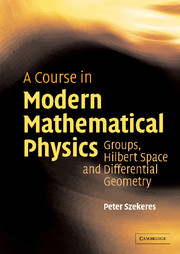Book contents
- Frontmatter
- Contents
- Preface
- Acknowledgements
- Dedication
- 1 Sets and structures
- 2 Groups
- 3 Vector spaces
- 4 Linear operators and matrices
- 5 Inner product spaces
- 6 Algebras
- 7 Tensors
- 8 Exterior algebra
- 9 Special relativity
- 10 Topology
- 11 Measure theory and integration
- 12 Distributions
- 13 Hilbert spaces
- 14 Quantum mechanics
- 15 Differential geometry
- 16 Differentiable forms
- 17 Integration on manifolds
- 18 Connections and curvature
- 19 Lie groups and Lie algebras
- Bibliography
- Index
11 - Measure theory and integration
Published online by Cambridge University Press: 05 September 2012
- Frontmatter
- Contents
- Preface
- Acknowledgements
- Dedication
- 1 Sets and structures
- 2 Groups
- 3 Vector spaces
- 4 Linear operators and matrices
- 5 Inner product spaces
- 6 Algebras
- 7 Tensors
- 8 Exterior algebra
- 9 Special relativity
- 10 Topology
- 11 Measure theory and integration
- 12 Distributions
- 13 Hilbert spaces
- 14 Quantum mechanics
- 15 Differential geometry
- 16 Differentiable forms
- 17 Integration on manifolds
- 18 Connections and curvature
- 19 Lie groups and Lie algebras
- Bibliography
- Index
Summary
Topology does not depend on the notion of ‘size’. We do not need to know the length, area or volume of subsets of a given set to understand the topological structure. Measure theory is that area of mathematics concerned with the attribution of precisely these sorts of properties. The structure that tells us which subsets are measurable is called a measure space. It is somewhat analogous with a topological structure, telling us which sets are open, and indeed there is a certain amount of interaction between measure theory and topology. A measure space requires firstly an algebraic structure known as a σ-algebra imposed on the power set of the underlying space. A measure is a positive-valued real function on the σ-algebra that is countably additive, whereby the measure of a union of disjoint measurable sets is the sum of their measures. The measure of a set may well be zero or infinite. Full introductions to this subject are given in [1–5], while the flavour of the subject can be found in [6–8].
It is important that measure be not just finitely additive, else it is not far-reaching enough, yet to allow it to be additive on arbitrary unions of disjoint sets would lead to certain contradictions – either all sets would have to be assigned zero measure, or the measure of a set would not be well-defined. By general reckoning the broadest useful measure on the real line or its cartesian products is that due to Lebesgue (1875–1941), and Lebesgue's theory of integration based on this theory is in most ways the best definition of integration available.
- Type
- Chapter
- Information
- A Course in Modern Mathematical PhysicsGroups, Hilbert Space and Differential Geometry, pp. 287 - 307Publisher: Cambridge University PressPrint publication year: 2004



